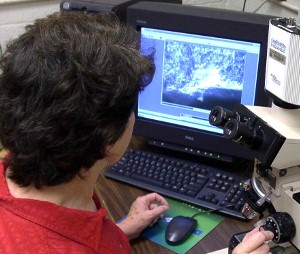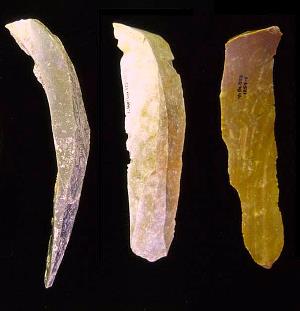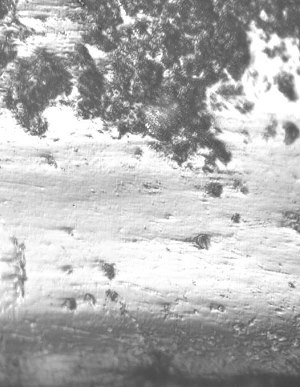Finding Microwear Patterns on Stone Tools

Patterns of wear on replicated stone tools used for woodworking are shown at a magnification of 500X. The three tools–an adze and two flakes–were crafted by a modern knapper and used for different tasks on different types of wood. Experimental tools such as these provide a comparative baseline for discerning microwear patterns on ancient tools, determining how they might have been used, and on what materials. Photos by Marilyn Shoberg.
|
One of the most interesting and useful areas of research into stone tools is also among the most time consuming. TARL analyst Marilyn Shoberg examines stone tools under a high powered microscope, searching for traces of past use—striations and residues typically not apparent to the naked eye. By comparing these wear patterns with those on experimental tools, she is able to link them with tool actions, such as scraping and cutting. Much of her research has focused on some very ancient tools—those from the Gault site in central Texas. It has attracted national and international attention because of the wealth of new information it has yielded, particularly on Clovis culture. Shoberg's work at TARL has involved acquiring and analyzing a set of experimental tools in order to have a comparative basis for analyzing dozens of archeological specimens from that site. In this feature, she discusses what can be learned from microwear analysis and the processes involved in this type of inquiry. By Marilyn Shoberg Some of the stone artifacts in an archeological assemblage are formal tools that have recognizable shapes such as projectile points, bifaces, or endscrapers. Many more artifacts appear to have been used, however, and unless we look at them under the microscope we can only guess at what their function may have been. When a stone tool is used, the edge is gradually worn away by the loss of flakes and abrasion. The surface is modified by contact with the worked material so that it appears shiny or polished. Microwear analysis is a systematic process of recording wear traces such as edge flaking, the surface characteristics of polish, and the orientation of striations on a stone tool in order to determine how that tool was used. The research microscope used at TARL for this analysis is an Olympus BH2 reflected light microscope with Nomarski optics. Observations are made at magnifications from 50X to 500X. Images of potentially diagnostic wear traces are captured with a digital Moticam camera. Microwear analysts learn how to identify the various attributes of wear traces by looking at experimental tools used in many different tasks on a wide variety of materials. It is absolutely essential for every analyst to do experiments and to acquire a reference collection of tools used in tasks relevant to prehistoric human behavior. The comparative collection of experimental tools we have at TARL is a terrific asset for analysis and teaching. It has grown from the work of many former students here at UT, archeologists and friends of archeology. The collection includes tools used on plant materials, several kinds of wood, bone, antler, elephant ivory, hide, and butchering a variety of animals. In addition to a large number of Clovis tools from the Gault Site, I have analyzed artifacts from a number of CRM projects in Texas, and sites in Arizona, Illinois, New Hampshire, Kentucky and Belize. In archeology we attempt to understand past human behavior from material culture; however only a very small fraction of that material culture survives. The things that people made from perishable organic materials such as plants, wood, bone, and skin are for the most part missing from the archeological record. The fascinating aspect of microwear analysis is that the tools used in the manufacture of the “missing majority” of that perishable material culture provide clues to the kinds of things people were making at particular places. Among the most interesting tools I have looked at are a small Clovis age flake used to incise bone, tools used to pierce animal skin, perhaps in the manufacture of clothing or shelter, and small prismatic blade fragments used in fine cutting or scraping tasks on grass, reed and wood. Sometimes you find an example of a recycled tool like a used-up projectile point re-purposed as a scraper or abrader on animal skin. More information about the Gault site, the artifacts examined for microwear traces, and the process of developing an experimental tool set can be found in the TBH Gault site exhibit. You are welcome to contact me to learn more about the research I conduct and to discuss my availability to contribute to projects under contract. My contact information is below: This Spotlight feature first appeared as a TARL Blog post. Follow the TARL Blog to learn more about TARL researchers, news about the lab, and the various types of research being conducted. To learn more about how microwear analysis has guided stone tool interpretation, visit the How Do We Know That? Use-Wear Analysis section of the TBH Varga site exhibit.
|
|


